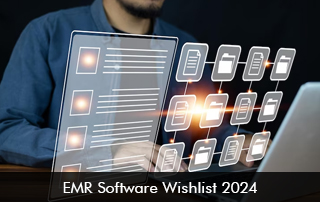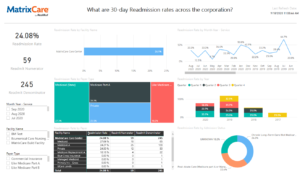The 2024 EMR software wishlist reflects the growing needs and expectations of healthcare providers and administrators. Electronic Medical Record (EMR) software plays a pivotal role in streamlining processes, improving patient care, and enhancing overall efficiency within healthcare organizations. This blog explores the key features and improvements that the healthcare industry hopes to see in EMR software in 2024.
Interoperable EMR Software and Data Exchange
One of the longstanding challenges in the healthcare sector has been the need for more seamless interoperability among different EMR systems. In 2024, the industry anticipates EMR software to prioritize interoperability, allowing smooth data exchange between various healthcare entities. A standardized and open data-sharing approach would reduce redundancies and ensure patient information is accessible across different platforms.
Additionally, integrating Application Programming Interfaces (APIs) would enable third-party applications to interact with EMR systems. This will foster innovation and customization. Furthermore, improved interoperability would empower healthcare providers to make informed decisions based on comprehensive and up-to-date patient data.
Enhanced User Experience
User experience is a critical factor in the successful adoption and utilization of EMR software. In 2024, the wishlist for EMR software includes a focus on user-centric design, intuitive interfaces, and efficient workflows. Healthcare professionals often face time constraints, and a user-friendly EMR system can significantly enhance their productivity.
Some desired features are – Intelligent design minimizing clicks, intuitive navigation, and personalized dashboards for different roles within the organization. The goal is to create an environment that facilitates quick and easy access to relevant patient information. Ultimately, the goal is to improve the overall user experience for healthcare providers.
Artificial Intelligence and Machine Learning Integration
Integrating Artificial Intelligence (AI) and Machine Learning (ML) capabilities can transform EMR software in 2024. That’s why it makes it to our wishlist. These technologies have the potential to revolutionize healthcare by automating routine tasks, providing data-driven insights, and facilitating predictive analytics.
Incorporating AI/ML into EMR software can assist in the early detection of diseases, predict patient outcomes, and optimize treatment plans. Natural Language Processing (NLP) could also play a role in converting unstructured clinical notes into structured data. This would make it considerably easier for healthcare professionals to extract meaningful information from patient records.
EMR Software Telehealth Integration
The global shift towards telehealth services has accelerated in recent years. EMR software is expected to seamlessly integrate with telehealth platforms in 2024. The ability to capture and store data from virtual visits within the EMR software ensures that all patient information, whether from in-person or virtual consultations, is consolidated in one secure location.
Moreover, EMR software should support features such as video consultations, remote monitoring, and secure messaging to facilitate comprehensive virtual care. This integration contributes to a more holistic approach to patient care, transcending physical boundaries and increasing accessibility to healthcare services.
Cybersecurity and Data Privacy
As healthcare organizations increasingly rely on digital platforms, the importance of robust cybersecurity measures cannot be overstated. The EMR software wishlist for 2024 includes enhanced cybersecurity features to protect patient data from potential threats and breaches.
End-to-end encryption, multi-factor authentication, and regular security updates are essential components of a secure EMR system. Additionally, compliance with data privacy regulations, such as the Health Insurance Portability and Accountability Act (HIPAA) in the United States, is paramount to maintaining patient trust and ensuring the confidentiality of medical records.
EMR Software Mobile Accessibility
The modern healthcare landscape demands flexibility and mobility. In 2024, healthcare professionals expect EMR software to be easily accessible through mobile devices. This will enable them to review patient records, input data, and make informed decisions on the go.
A mobile-friendly interface would cater to the needs of busy clinicians and empower patients to engage with their health information. Mobile accessibility contributes to a more dynamic and responsive healthcare ecosystem, aligning with the expectations of both healthcare providers and patients.
Advanced Analytics and Reporting
Comprehensive analytics and reporting capabilities are crucial to derive insights from vast amounts of data stored in EMR systems. The 2024 EMR software wishlist must include advanced analytics tools. These tools enable healthcare providers to identify trends, assess performance, and make data-driven decisions.
Customizable reporting features, real-time dashboards, and predictive analytics contribute to a more proactive approach to healthcare management. By harnessing the power of data, healthcare organizations can optimize resource allocation, improve patient outcomes, and enhance overall operational efficiency.
EMR Software Patient Engagement Tools
Patient involvement in their healthcare journey is very important. That’s why the wishlist for EMR software in 2024 includes robust patient engagement tools. Features such as secure patient portals, appointment scheduling, and personalized health information encourage an active role in health management.
Furthermore, integration with wearable devices and health apps allows for continuous monitoring and data collection. This provides healthcare providers with a more holistic view of a patient’s well-being. Patient engagement tools contribute to a collaborative and patient-centered approach to healthcare.








